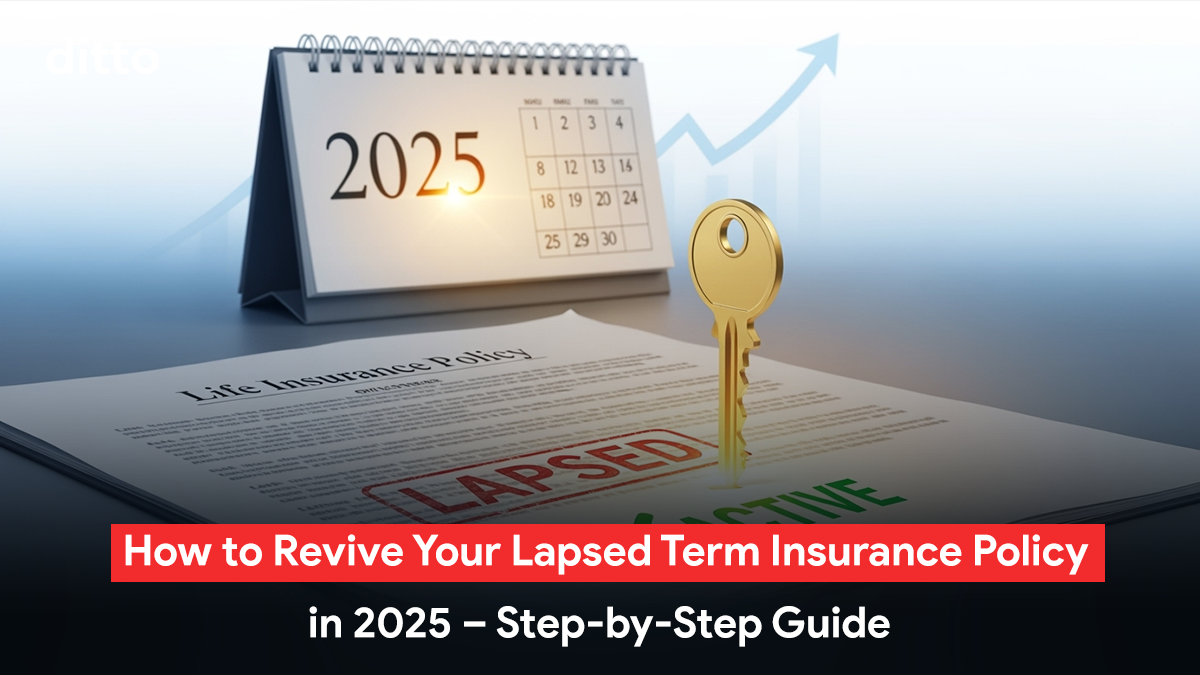How to revive a lapsed term insurance policy?
Term insurance is meant to be simple: Pay your premiums, and your family gets a payout if something happens to you. But what if you miss a payment? Or worse, your policy lapses?
You might assume the insurer will remind you. Or that revival is just a matter of paying a little late fee. But that’s rarely the case.
At Ditto, we’ve helped revive hundreds of lapsed term policies and here’s what we’ve learned: while the IRDAI (regulator) gives you a five-year window to revive your policy, most insurers don’t make it easy. Some insist on branch visits. Others demand fresh medical tests. And if your health has changed in the meantime, they may load (increase) your premium or reject the revival altogether.
In this article, we’ll break down what the regulator allows, how insurers interpret it, and what you should expect if you’re looking to revive a lapsed term policy.
Don’t wait, revival gets tougher the longer you delay. Talk to a Ditto advisor today and get your cover back on track.
When does a term insurance policy lapse?
A term insurance policy is considered lapsed when:
The due premium is not paid even after the grace period ends (30 days for annual, half-yearly, or quarterly payments; 15 days for the monthly mode)
Note: 30 days here refers to calendar days and not working days
What happens when a policy lapses?
- The risk cover stops: The insurer is no longer liable to pay the death benefit if the life assured dies after the lapse date.
- Any riders attached (e.g. critical illness, waiver of premium) also lapse.
Can you revive a lapsed term insurance policy?
Yes.
According to IRDAI guidelines, you can revive a lapsed non-linked term insurance policy within 5 years from the date of the first missed premium.
Here’s how to revive a lapsed term insurance policy
- Inform the insurer: Raise a revival request through their portal, customer care, or by visiting a branch.
- Pay overdue premiums: You’ll need to clear all unpaid premiums.
- Pay revival interest: Most insurers charge an interest on the total outstanding that compounds every year (expect RBI bank rate + 3%).
- Submit documents: This usually includes a medical declaration, and may include fresh test reports depending on the time elapsed.
- Undergo underwriting (if required): The insurer may reassess your risk through tele-medicals or lab tests. If all goes well, they’ll reinstate your policy.
That’s the theory. In reality, reviving a lapsed policy is far more complicated.
We reviewed the revival process for three major insurers—HDFC Life, ICICI Pru, and Axis Max Life and here’s what we found.
Why Policy Revival Isn’t Easy: What Top Insurers Actually Require
1. Medical underwriting kicks in quickly
Once the 30 day grace period ends, all three insurers require a medical declaration to even initiate revival. But after 60–75 days, it shifts to full-fledged medical underwriting. This includes medicals, lab tests, and occasionally stress tests for older policyholders or high cover amounts (₹1 Cr+).
Our data shows that 90% of revivals after 60 days involve some form of fresh medicals. If your reports show deteriorating health (like high cholesterol or HbA1c), the insurer may:
- Load your premium (typically 25–100%)
- Reject the revival altogether
Important legal implications of revival
Revival isn’t just a formality—it actually resets some key clauses in your policy:
- Section 45 contestability clock restarts: By law, a life insurance policy can’t be questioned after 3 years from the latest of (i) issuance, (ii) risk commencement, (iii) rider addition, or (iv) revival. Since revival is included, the 3-year “contestability” period restarts. This means the insurer once again has the right to question misstatements, non-disclosures, or even fraud for the next 3 years after revival.
- Suicide exclusion resets: Most term policies exclude death due to suicide for 12 months from policy start. On revival, this exclusion typically restarts for another 12 months. Always check your policy wording to confirm.
These reset clauses are often overlooked but can significantly impact your family’s claim eligibility if something happens soon after revival.
| Insurer | Medicals Start | Medical Declaration |
|---|---|---|
| HDFC Life | After 75 days | Required post grace period |
| ICICI Pru | After 60 days | Required post grace period |
| Axis Max Life | After 60 days | Required post grace period |
2. Branch visits may be required sometimes
Some insurers may request branch visits, even if it’s not compulsory. For instance, if your HDFC Life policy has lapsed for more than 75 days, you may be asked to visit a branch in person to revive it. However, for online policies, this requirement is generally waived. Additionally, medicals are only scheduled after you’ve submitted your documents and declaration physically. This alone can delay the process by 2–3 weeks.
ICICI Pru and Max Life don’t require branch visits, but they do enforce stricter medicals and full documentation once you cross the 60-day mark.
3. Revival becomes extremely difficult after 3 years
IRDAI gives you 5 years to revive a lapsed policy, but all three insurers become far more conservative after year 3. Medical tests are non-negotiable. Approval rates drop. Even controlled conditions like diabetes or hypertension can lead to outright rejection.
At that point, buying a fresh policy may be simpler and faster, though potentially more expensive.
So what should you do if you want to revive a lapsed term policy?
- Within 30 days (grace period): Just pay the premium. You can request a payment link through the insurer’s portal, app, or customer support. No medical declaration is needed. No medical tests. No paperwork. The policy is revived instantly.
- 31–60 days: Submit a good health declaration. Most insurers won’t ask for medical tests at this stage, but revival isn’t instant—you’ll need to raise the request through the insurer’s portal or customer support. However, note that insurers classify policies as either standard or sub-standard. A sub-standard policy is one that was originally issued with a counter-offer or loading charges. For such policies, insurers can demand medical tests as soon as the grace period lapses, even within this 31–60 day window.
- After 60 days: You will most likely have to go through a full medical underwriting. You'll probably need lab tests, possibly a branch visit (HDFC Life after 75 days), and approvals take longer. Revival is still possible, but harder and not guaranteed.
Final thoughts
Reviving a lapsed term insurance policy is possible—but rarely as simple as it sounds. While IRDAI allows a five-year revival window, insurers apply that rule very differently. Beyond the grace period, the process often shifts from a quick payment to full medical underwriting, paperwork, and delays.
The sooner you act, the smoother your experience. If your policy has lapsed, raise a request right away. And if you're unsure whether revival makes financial sense—or if it's better to buy a new plan—speak to a Ditto advisor. We'll help you weigh the options and choose the most cost-effective path forward.
Last updated on:










